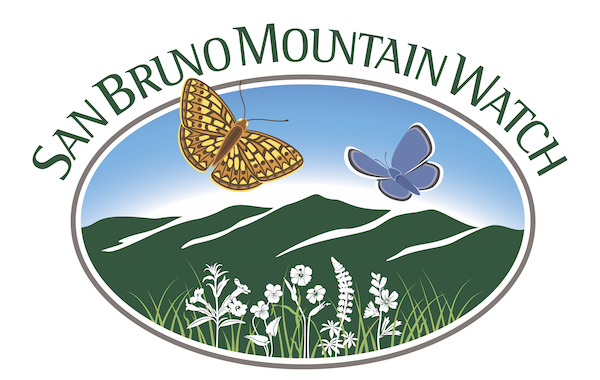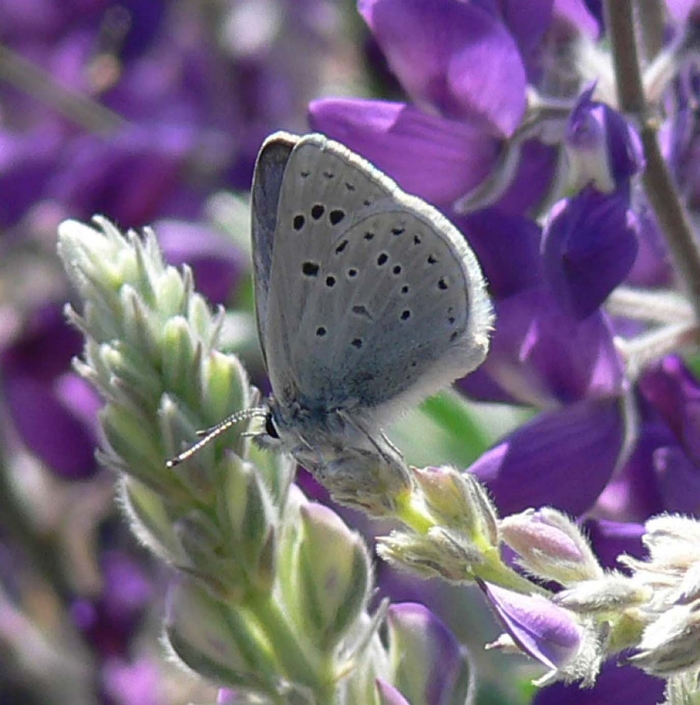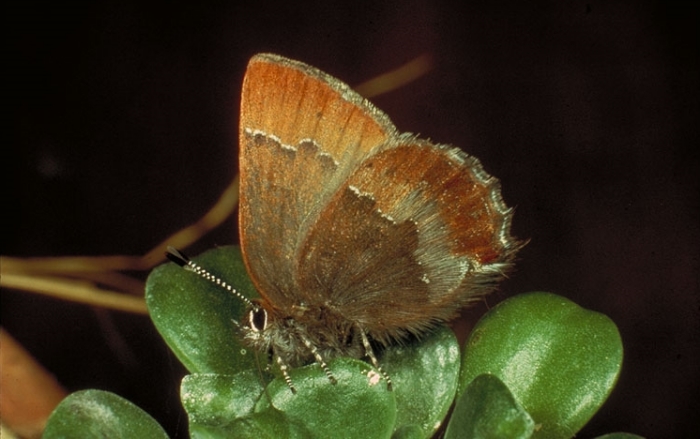Three rare and endangered butterflies struggle to survive on San Bruno Mountain - the Mission Blue, the San Bruno Elfin and the Callippe Silverspot. All are federally listed as endangered and San Bruno Mountain is the only place on the planet where these 3 species coexist. These rare butterflies have very specific habitat requirements - and butterfly habitat on San Bruno Mountain is under constant threat. Loss of habitat means loss of butterflies.
These three butterflies have several things in common: all are subspecies of more common butterflies; all are host plant-specific - see description below; all have limited range; all have very short adult stages; all have one-year life cycles - explanation of stages below; and all find their largest population here on San Bruno Mountain.
Host Plant-Specific Butterflies - the importance of habitat protection
Butterflies require both nectar plants to feed adults and host plants to house and feed larvae (caterpillars). Many butterflies use a variety of plants (polyphagous butterflies) as host plants and those species tend not to be endangered - they have an easier time and can adapt to varied habitats.
Host-specific butterflies have a harder time - some may be able to use more than one species from one plant genus (the Mission Blue can use 3 different species of lupine), but frequently butterflies will rely solely on one plant species to lay their eggs and feed the larvae (caterpillars). The Callippe Silverspot, for example, must use the California Golden Violet (Viola pedunculata) and the San Bruno Elfin must use the Pacific Stonecrop (Sedum spathulifolium). Consequently, the disappearance of the host plant, for any reason, spells disaster - and the extermination of the species.
Butterfly Life Cycle - a yearlong process of metamorphosis
There are four stages in butterfly development: egg, larva (caterpillar), pupa and adult.
Egg: This is where life begins.
Larva (caterpillar): This is when most of the feeding and growth occurs. There are several stages of larval development, each stage called an instar (first instar, second instar, etc.) The larva molts between each instar stage.
Diapause: Our three butterflies spend about 85% of their life cycle in this hormonally-induced state of quiescence (period of inactivity). Each butterfly enters diapause at different developmental stages. For our three endangered species, diapause is at the larval or pupal stage of development.
Pupa: The "magic" happens here as the full grown larva (caterpillar) becomes an adult butterfly. Some insect larva spin a cocoon but these three butterflies form a hard shell called a chrysalis after the full grown larva sheds its skin for the last time.
Adult: The beautiful butterfly we enjoy must now mate and lay eggs for a next generation. The adult stage butterfly only lives for a couple of weeks.
Footnote: Habitat is critical to San Bruno Mountain's butterflies. The major threats to loss of habitat are development, non-native invasive plants, and natural scrub succession. Plant succession is a natural process where a few species of plants expand to dominate a habitat when they have the opportunity and no negative factors. Succession can be slowed and reversed using a strategy of controlled burns, which also benefits the required host plants. All three species of endangered butterflies evolved with fire being a natural part of their environment and have adapted by spending the majority of their life cycle on the ground or in the ground around their host plant.
Mission Blue Butterfly - Endangered
Listed 1976
Icaricia icarioides missionensis
Family: Lycaenidae
Mission Blue butterfly
Status: The Mission Blue Butterfly was listed as endangered in 1976 and is a subspecies of Boisduval’s Blue. At that time it was found on San Bruno Mountain, Twin Peaks in San Francisco, Milagra Ridge bordering Pacifica and San Bruno, and the Marin Headlands west of the Golden Gate Bridge. As the name suggests, it is a small blue butterfly with a one inch wingspan.
Its preferred host plant, Silver Bush Lupine (Lupinus albifrons) is susceptible to dieback caused by a fungal infection in very wet years. This situation caused the butterfly to be extirpated from Twin Peaks and it is currently threatening the populations in Marin and Milagra Ridge. Fortunately, San Bruno Mountain supports Summer Lupine (L. formosus) and Varied Lupine (L. variicolor) which the butterfly will also use. Varied Lupine is the least-used plant and is more solitary and random in distribution. Silver Bush Lupine and Summer Lupine tend to appear in small, but separate, communities.
Mission Blue eggs on lupine leaves
Life Cycle: Adult females typically lay eggs on lupine leaves, flowers or seedpods. The egg hatches and the new larva seeks out the leaves. It eats the mesophyll which is the nutrient-rich middle layer of the leaf, similar to eating the lunchmeat in a sandwich and leaving the slices of bread. As the larva grows it must shed its skin by molting and the time between molts is known as an instar.
The Mission Blue larva enters diapause as a second-stage instar by moving into the litter beneath the plant or into the loose dirt. Depending on microclimates, larvae awaken at varying times and resume feeding in late winter. During their third and fourth instars they secrete honeydew, which several native ant species feed on. In exchange, the ants tend to the larvae and protect them from predators and parasites. This behavior is common in butterflies in the family Lycaenidae.
Native ants on Mission Blue caterpillar
The mature larva attaches itself to a solid surface and sheds its skin. The newly exposed exterior hardens into a chrysalis and the pupal stage lasts for about 10 days and an adult emerges. The adult Mission Blue lives for about 6-10 days, so mating and egg-laying must be done quickly, sometimes even ignoring nectar as they frantically try to begin a new generation.
SAN BRUNO ELFIN BUTTERFLY - ENDANGERED
Callophrys mossii bayensis
Family: Lycaenidae
Listed 1976
All adult elfin species, regardless of location or elevation, are among the earliest to emerge. The San Bruno Elfin begins its flight season in February. Like the Mission Blue, it is also a lycaenid and is therefore tended by native ants in its later larval (instar) stages.
Status: The San Bruno Elfin Butterfly was listed as endangered in 1976 and is a subspecies of Moss’ Elfin. About the size of a Mission Blue, this small, brown butterfly’s distribution is limited to San Bruno Mountain, and Montara Mountain and Sharp Park in Pacifica. It may have existed in the Presidio, Lincoln Park and Twin Peaks in San Francisco but is assumed extirpated there due to development.
Life Cycle: Its host plant is stonecrop (Sedum spathulifolium) and, as the common name implies, this plant favors rocky outcrops with a northern exposure. Since these outcrops usually appear near the summit of the mountain, no elfin habitat was threatened by planned development.
Stonecrop with maturing flower stalk
Sedum is a succulent plant with smooth fleshy leaves. The female lays eggs on the leaves and the eggs hatch about a week later. The larvae bore into the leaves to feed. While they feed on the leaves the plant develops a stalk with immature flowers buds. The stem continues to elongate and the buds explode into a riotous carpet of bright yellow flowers.
Stonecrop flowers are food!
The tiny reddish-to-yellow larva migrates up to the flowers and begins to devour the protein-rich blooms. It is at this half-grown stage that the larva secretes honeydew which attracts native ants. In late May or early June the larva reaches maturity and migrates beneath the plant where it develops into a chrysalis. This pupal stage will last until it emerges as an adult the following February.
CALLIPPE SILVERSPOT BUTTERFLY - ENDANGERED
Speyeria callippe callippe
Family: Nymphalidae
Listed 1997
Callippe Silverspot Butterfly
Status: The Callippe Silverspot Butterfly was listed as endangered in 1997 and was recently added to the Habitat Conservation Plan (HCP) for San Bruno Mountain. It is a subspecies which is distinct from S. callippe comstockii to the south and S. callippe liliana to the north. Unlike the smaller Mission Blue or the San Bruno Elfin (wingspan about 1 inch) the Silverspot is a large, magnificent orange-brown butterfly whose wingspan is about 2.5 inches.
It is a subspecies of the Callippe Fritillary (Speyeria callippe), a variable species that is present in 11 northwestern states and southwestern Canada. Whereas the blue and the elfin rarely venture beyond a quarter-mile of their birthplace, the callippe has no qualms flying three-quarters of a mile searching for its host plant, the California Golden Violet (Viola pedunculata). On the San Francisco Peninsula, the Callippe Silverspot's distribution is limited to San Bruno Mountain. It is also found at Redwood Regional Park in Alameda County, and areas near Vallejo. The populations at Redwood Park are thought to be a transitional species between S. callippe callippe and S. callippe comstockii. Populations near Vallejo are increasingly becoming hybrids between S. callippe callippe from the south and S. callippe liliana that extends to a few counties north of there.
Callippe Silverspots mating
Life Cycle: The beginning of the Callippe Silverspot's life is very peculiar. By the time the adult female is ready to lay eggs in June the host plant has desiccated — dried out. The eggs are laid on or near the violet and hatch in about a week. The larvae may eat the egg shell and crawl into the ground under the plant and enter diapause until late winter.
The seasonal rains cause the violet to spurt new growth and the small caterpillar awakens to feed primarily during the night. It completes its larval stage and enters its 2-week pupal stage in April or May. The callippe is part of a group of butterflies known as hilltoppers. The male adults emerge and fly to nearby ridge tops (hilltopping behavior) where they patrol for females. After mating, the females seek the clumps of what are now dead and dying violet plants to lay their eggs and begin a new generation.




